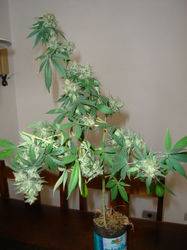B
bonecarver_OG
sometimes i make funny misstakes.
i was cutting holes in 130 small plastic cups and smoking spliffs before planting those seeds.. now yesterday we realize there was 2 that didnt have holes in the botom - and they have been about 1 week without water - atleast. since to be able to suck from the tray it needs to be able to have holes hehe.. they were alive - a lsdc and a PTK pure from tomhill.. so we got some sturdy genetics here they obviously got sorted out -lets see how they go.
they obviously got sorted out -lets see how they go.
i was cutting holes in 130 small plastic cups and smoking spliffs before planting those seeds.. now yesterday we realize there was 2 that didnt have holes in the botom - and they have been about 1 week without water - atleast. since to be able to suck from the tray it needs to be able to have holes hehe.. they were alive - a lsdc and a PTK pure from tomhill.. so we got some sturdy genetics here








